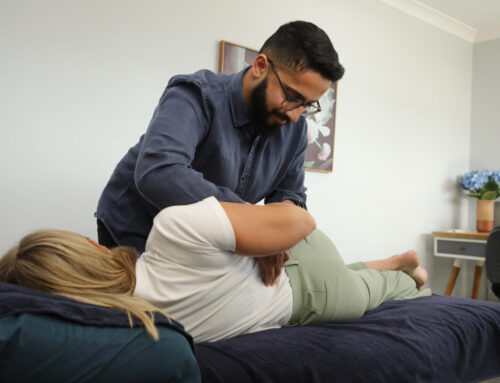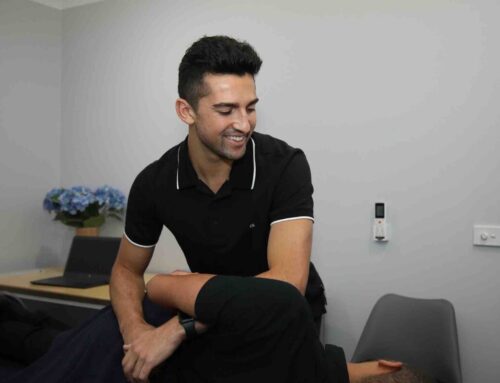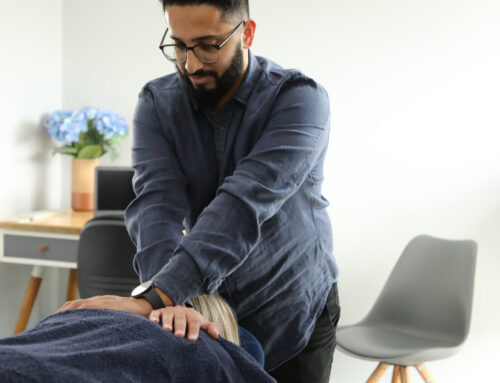At some point in your life, you have either cracked your own knuckles or have heard someone else crack theirs. In some cultural contexts cracking your knuckles can be seen as a declaration of war, in others, it is merely an expression of restless fidgeting.
Now whether you can stand the sound of the cracking or not is a completely different topic. This “cracking” sound doesn’t only occur in your knuckles, but in most other joints, including the spine. If you’ve ever had neck or back pain and been to an Osteopath or Chiropractor, they commonly use spinal manipulation as a technique to alleviate this pain. Quite often people aren’t aware of where that sound emanates from or what it means. This ends up perpetuating the fear of the unknown. So, this blog will address some of the common misconceptions about cracking.
What is the cracking sound?
That popping or cracking sound you hear? It’s called a cavitation. To understand what a cavitation is we need to understand how a joint works. The joints in our body have something called synovial fluid which lies in the junction where the bones meet, helping to lubricate the bones to avoid grinding on each other. There is some gas that’s already dissolved in the fluid. When the bones get pulled away from each other a sudden drop in pressure in the middle of the joint occurs. Lower pressures allow the gases to come together which then forms a gas bubble in the joint.
How do we know that’s what happens in the joint?
Previous theories thought the sound occurred due to a pop of the gas bubble in the joint, however a study by Kawchuk et al. (2015) investigated this theory by observing the joint “pop” in real time under an MRI scanner. Results indicated that as the joints in the fingers were distracted (pulled apart) the formation of a gas bubble in the joint occurred, disproving previous theories.
Fig 1.
Figure 1. Static image before (left) and after (right) joint distraction.
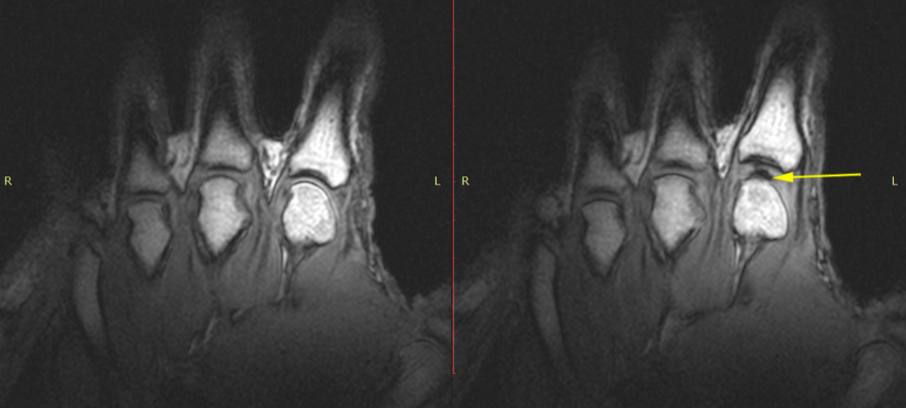
What is spinal manipulation and how does it relate to the popping sound?
Spinal manipulation (also called high velocity-low amplitude (HVLA) in Osteopathy) is a common technique that engages a restriction in your joints with a short controlled thrust in order to increase motion and decrease pain. Once the thrust is applied there is a momentary increase of joint space which pulls the bones away from each other, which as we previously mentioned is the recipe that creates a cavitation. People often associate the effectiveness of the technique by hearing the pop, however this is not true. A study by Cleland et al. (2007) investigated the relationship between the audible pop and improvements in pain and function and found no statistical significance or relationship between the two.
Is manipulation dangerous and will I get arthritis from cracking my joints?
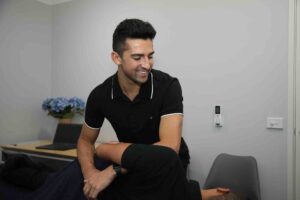 Contrary to popular belief, there is no evidence to suggest that this technique can cause arthritis, which I’m sure many parents told their children to get them to stop clicking their fingers. In fact, Dr Donald Unger spent 50 years cracking the knuckles of only his left hand at least twice a day. At the end of the 50 years his hands were then compared for the presence of arthritis, there was no arthritis in either hand and no apparent differences between the two hands (Unger, 1998).
Contrary to popular belief, there is no evidence to suggest that this technique can cause arthritis, which I’m sure many parents told their children to get them to stop clicking their fingers. In fact, Dr Donald Unger spent 50 years cracking the knuckles of only his left hand at least twice a day. At the end of the 50 years his hands were then compared for the presence of arthritis, there was no arthritis in either hand and no apparent differences between the two hands (Unger, 1998).
In terms of spinal manipulation, the technique is relatively safe and the only reported cases of injury occurred when the patient was not adequately screened and had underlying conditions that predisposed them to injury.
What are the benefits of spinal manipulation?
The study by Fryer (2017) discussed several of the benefits of spinal manipulation, which include:
- Increased joint range of motion
- Decreased pain levels
- Decreased muscle tone
- Release of endorphins
- Helps with swelling and fluid drainage
Many people often seek out spinal manipulation as they notice a quicker onset of short-term relief when compared to other techniques. This technique is also recommended in national guidelines of care for low back pain. In 2017 low back pain was estimated to affect about 577 million people globally.
Now the next time someone is apprehensive about spinal manipulation or tries to berate you for cracking your knuckles, you can be the one to bust the myth surrounding that mysterious ‘pop’.
References:
Cleland, J. A., Flynn, T. W., Childs, J. D., & Eberhart, S. (2007). The audible pop from thoracic spine thrust manipulation and its relation to short-term outcomes in patients with neck pain. The Journal of manual & manipulative therapy, 15(3), 143-154. https://doi.org/10.1179/106698107790819828
Fryer, G. (2017, 2017/12/01/). Integrating osteopathic approaches based on biopsychosocial therapeutic mechanisms. Part 2: Clinical approach. International Journal of Osteopathic Medicine, 26, 36-43. https://doi.org/https://doi.org/10.1016/j.ijosm.2017.05.001
Galindez-Ibarbengoetxea, X., Setuain, I., Andersen, L. L., Ramírez-Velez, R., González-Izal, M., Jauregi, A., & Izquierdo, M. (2017, 2017/09/01). Effects of Cervical High-Velocity Low-Amplitude Techniques on Range of Motion, Strength Performance, and Cardiovascular Outcomes: A Review. The Journal of Alternative and Complementary Medicine, 23(9), 667-675. https://doi.org/10.1089/acm.2017.0002
Gevers-Montoro, C., Provencher, B., Descarreaux, M., Ortega de Mues, A., & Piché, M. (2021, 2021-October-25). Clinical Effectiveness and Efficacy of Chiropractic Spinal Manipulation for Spine Pain [Review]. Frontiers in Pain Research, 2. https://doi.org/10.3389/fpain.2021.765921
Gibbons, P., & Tehan, P. (2006, 2006/03/01/). HVLA thrust techniques: What are the risks? International Journal of Osteopathic Medicine, 9(1), 4-12. https://doi.org/https://doi.org/10.1016/j.ijosm.2006.02.005
Gómez, F., Escribá, P., Oliva-Pascual-Vaca, J., Méndez-Sánchez, R., & Puente-González, A. S. (2020). Immediate and Short-Term Effects of Upper Cervical High-Velocity, Low-Amplitude Manipulation on Standing Postural Control and Cervical Mobility in Chronic Nonspecific Neck Pain: A Randomized Controlled Trial. Journal of clinical medicine, 9(8), 2580. https://doi.org/10.3390/jcm9082580
Hammell, L., & Null, M. (2022). Osteopathic Manipulative Treatment: HVLA Procedure – Thoracic Vertebrae. In StatPearls. StatPearls Publishing
Copyright © 2022, StatPearls Publishing LLC.
https://www.ncbi.nlm.nih.gov/books/NBK562143/
Kawchuk, G. N., Fryer, J., Jaremko, J. L., Zeng, H., Rowe, L., & Thompson, R. (2015). Real-Time Visualization of Joint Cavitation. PLOS ONE, 10(4), e0119470. https://doi.org/10.1371/journal.pone.0119470
Recommendations | Low back pain and sciatica in over 16s: assessment and management | Guidance | NICE. Nice.org.uk. (2016). Retrieved 13 June 2022, from https://www.nice.org.uk/guidance/ng59/chapter/recommendations
Unger, D. L. (1998, May). Does knuckle cracking lead to arthritis of the fingers? Arthritis Rheum, 41(5), 949-950. https://doi.org/10.1002/1529-0131(199805)41:5<949::Aid-art36>3.0.Co;2-3
Wu, A., March, L., Zheng, X., Huang, J., Wang, X., Zhao, J., Blyth, F. M., Smith, E., Buchbinder, R., & Hoy, D. (2020). Global low back pain prevalence and years lived with disability from 1990 to 2017: estimates from the Global Burden of Disease Study 2017. Annals of translational medicine, 8(6), 299-299. https://doi.org/10.21037/atm.2020.02.175
